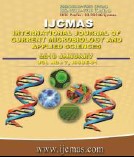


 National Academy of Agricultural Sciences (NAAS)
National Academy of Agricultural Sciences (NAAS)

|
PRINT ISSN : 2319-7692
Online ISSN : 2319-7706 Issues : 12 per year Publisher : Excellent Publishers Email : editorijcmas@gmail.com / submit@ijcmas.com Editor-in-chief: Dr.M.Prakash Index Copernicus ICV 2018: 95.39 NAAS RATING 2020: 5.38 |
Tannins are water soluble Polyphenols, known as proanthocyanidins possessing useful properties such as antioxidant, anti- apoptosis, and anti-aging, anti-carcinogenic, anti-inflammatory as well as anti-atherosclerosis and cardiovascular protection. In this study tannin content in various arecanut samples was assessed by titrimetric method. Arecanut samples were collected from Shimoga, Davanagere, Chikkamagalur, Chitradurga, Dakshina kannada (DK) and Udupi districts of Karnataka, India. The dried powdered arecanut samples were used for the estimation of Tannin content. Tannin contents in different districts ranged from 1.13% to 3.39%. The Concentration of Tannin varied significantly among hoblies and districts of Karnataka state. Crude fiber in tender areca nuts is very low (1- 2%). With maturity and ripening, fiber forms continuously and the rate of formation increases from the mature green stage. Fiber is responsible for the hardness of the nuts, which takes place after the mature- green stage, when nuts are taken to prepare the cut and boiled types known as kalipak. In Shimoga district, Sagara and Hosanagara taluks had high fiber content (65.22 and 62.36 %) and less was seen in Bhadravathi taluk (36.33 %). In Tarikere and N R pura taluks of Chikkamagalur district, high amount of fiber contents of 57.51 and 56.19 % was recorded, and it was less in Mudigere taluk (28.02 %). 52.80 and 52.78 per cent of fiber were observed in Harihara and Jagalur taluk of Davanagere district. There was no significant difference in fiber content of Chitradurga district. The diversity in tannin and fiber content may be due to variability in processing technique, climate, varieties, water stress, soil conditions etc.
 |
 |
 |
 |
 |